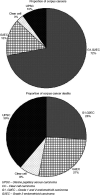Uterine papillary serous and clear cell carcinomas predict for poorer survival compared to grade 3 endometrioid corpus cancers
- PMID: 16495918
- PMCID: PMC2361201
- DOI: 10.1038/sj.bjc.6603012
Uterine papillary serous and clear cell carcinomas predict for poorer survival compared to grade 3 endometrioid corpus cancers
Abstract
To compare the survival of women with uterine papillary serous carcinoma (UPSC) and clear cell carcinoma (CC) to those with grade 3 endometrioid uterine carcinoma (G3EC). Demographic, pathologic, treatment, and survival information were obtained from the Surveillance, Epidemiology, and End Results Program from 1988 to 2001. Data were analysed using Kaplan-Meier and Cox proportional hazards regression methods. Of 4180 women, 1473 had UPSC, 391 had CC, and 2316 had G3EC cancers. Uterine papillary serous carcinoma and CC patients were older (median age: 70 years and 68 vs 66 years, respectively; P<0.0001) and more likely to be black compared to G3EC (15 and 12% vs 7%; P<0.0001). A higher proportion of UPSC and CC patients had stage III-IV disease compared to G3EC patients (52 and 36% vs 29%; P<0.0001). Uterine papillary serous carcinoma, CC and G3EC patients represent 10, 3, and 15% of endometrial cancers but account for 39, 8, and 27% of cancer deaths, respectively. The 5-year disease-specific survivals for women with UPSC, CC and G3EC were 55, 68, and 77%, respectively (P<0.0001). The survival differences between UPSC, CC and G3EC persist after controlling for stage I-II (74, 82, and 86%; P<0.0001) and stage III-IV disease (33, 40, and 54; P<0.0001). On multivariate analysis, more favourable histology (G3EC), younger age, and earlier stage were independent predictors of improved survival. Women with UPSC and CC of the uterus have a significantly poorer prognosis compared to those with G3EC. These findings should be considered in the counselling, treating and designing of future trials for these high-risk patients.
Figures
References
-
- Abeler VM, Kjorstad KE (1991) Clear cell carcinoma of the endometrium: a histopathological and clinical study of 97 cases. Gynecol Oncol 40: 207–217 - PubMed
-
- Abeler VM, Vergote IB, Kjorstad KE, Trope CG (1996) Clear cell carcinoma of the endometrium. Prognosis and metastatic pattern. Cancer 78: 1740–1747 - PubMed
-
- Alektiar KM, McKee A, Lin O, Venkatraman E, Zelefsky MJ, McKee B, Hoskins WJ, Barakat RR (2002) Is there a difference in outcome between stage I–II endometrial cancer of papillary serous/clear cell and endometrioid FIGO Grade 3 cancer? Int J Radiat Oncol Biol Phys 54: 79–85 - PubMed
-
- Bokhman JV (1983) Two pathogenetic types of endometrial carcinoma. Gynecol Oncol 15: 10–17 - PubMed
-
- Boruta II DM, Gehrig PA, Groben PA, Bae-Jump V, Boggess JF, Fowler Jr WC, Van Le L (2004) Uterine serous and grade 3 endometrioid carcinomas: is there a survival difference? Cancer 101: 2214–2221 - PubMed
Publication types
MeSH terms
LinkOut - more resources
Full Text Sources
Other Literature Sources




